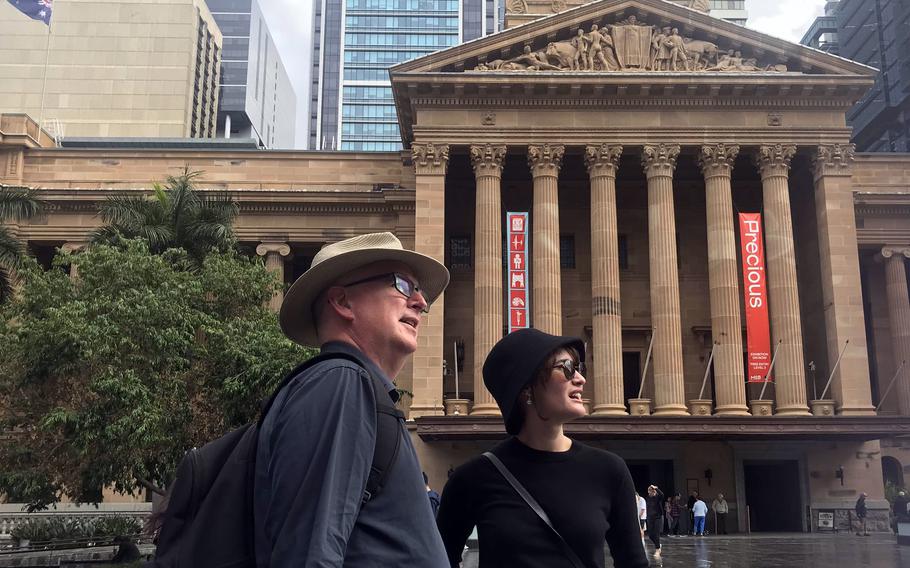
Museum of Brisbane tour guide Brian Ogden and marketing manager Rachel Murphy visit the Australian city's King George Square, July 22, 2025. (Seth Robson/Stars and Stripes)
American service members in Australia can find remnants of their World War II predecessors in the center of one of the country’s largest cities.
Brisbane, in the eastern state of Queensland, has served as a hub for some of the 35,000 troops from the United States, Australia and 17 other nations during the Talisman Sabre exercise that began July 13 and wrapped up Aug. 4.
At the start of World War II, 330,000 people living in the city were joined by almost as many foreign troops, including Dutch soldiers, retreating from Japan’s advance through the Pacific.
Around a million American soldiers passed through Australia during the war, said Brian Ogden, a guide with the Museum of Brisbane’s Walking in Wartime tour.
The tour starts at the museum, on the third floor of Brisbane City Hall, a short taxi ride from Gallipoli Barracks or a slightly longer ride from Royal Australian Air Force Base Amberley.
The 90-minute tour takes in nearby spots familiar to American forces during the war.
The first stop is the city hall’s basement, where the wall of what was once a public toilet includes graffiti drawn by U.S. troops during the war.
Across King George Square stands the Albert Street Uniting Church, where many U.S. service members married local brides, Ogden told Stars and Stripes in front of the building on July 22.
“This church held 16 weddings a day during the war,” he said. “Around 7,000 Queensland women married Americans and moved to the U.S. after the war.”
So many Australian women married GIs that the U.S. legislators passed a law in 1945 to help them move to America, he said.
Wartime troops packed local theaters and hotels to see entertainers who flew out from the U.S., Ogden said.
“They would bring out the latest jazz and dance band music,” he said. “After the war, the jazz scene in Brisbane was more advanced than in larger cities such as Sydney and Melbourne.”
Film stars such as Gary Cooper, John Wayne and Bob Hope stopped in Brisbane to entertain the troops and first lady Eleanor Roosevelt gave a speech at the city hall, Ogden said.
Brisbane’s sprawl was an advantage when it came to accommodating troops. The town was second only to Los Angeles in land area in 1939.
The Americans built new airfields and camped out at showgrounds and racecourses around Brisbane, Ogden said.
The town had a busy port, where more than 700 ships docked from 1938 to 1939, he said.
A convoy bound for Manila diverted to Brisbane after Japan invaded the Philippines, Ogden said.
Modern-day Brisbane, home to 2.7 million, boasts a skyline of glittering skyscrapers that dwarf the tallest buildings of the 1940s.
Back then, the city hall was the most prominent structure in a town where the largest buildings were theaters, banks and cathedrals, Ogden said.
ANZAC Square, a short walk from the museum, was created in 1930 to honor the Australian and New Zealand Army Corps’ service in World War I. Tributes to those who fought in World War II and other conflicts have been added.
Nearby stands a multistory building that housed an American Post Exchange during the war.
On Thanksgiving Day 1942, U.S. Army Pvt. James Stein had an altercation with some Australian soldiers nearby, Ogden said.
A group of U.S. military police got involved, and eventually hundreds of Australian troops and American MPs were facing off in front of the exchange, he said.
The fighting escalated to the point where a blast from an MP’s shotgun killed one Australian and injured eight others, he said.
The last stop on the tour is the MacArthur Museum, formerly the headquarters of then-U.S. Army Lt. Gen. Douglas MacArthur.
MacArthur’s wartime office in Brisbane’s historic AMP building looks exactly like it did when it was the focal point for the Pacific campaign.
The U.S. 7th Fleet, now headquartered at Yokosuka Naval Base, Japan, was formed there on March 15, 1943.
The museum, which opened in 2004, includes exhibits detailing MacArthur’s time in Brisbane and the city’s role in World War II.
Walking in Wartime tour
Directions: Brisbane City Hall is about a quarter-mile walk along Ann Street from the city’s Central Station.
Times: Walking in Wartime tours take places between 10:30 a.m. and noon on select Sundays.
Costs: $35 per person for an up-to-12-person tour, plus a booking fee.
Food: The historic Shingle Inn on the ground floor of Brisbane City Hall serves coffee and snacks.
Information: Online: museumofbrisbane.com.au/whats-on/walking-in-wartime